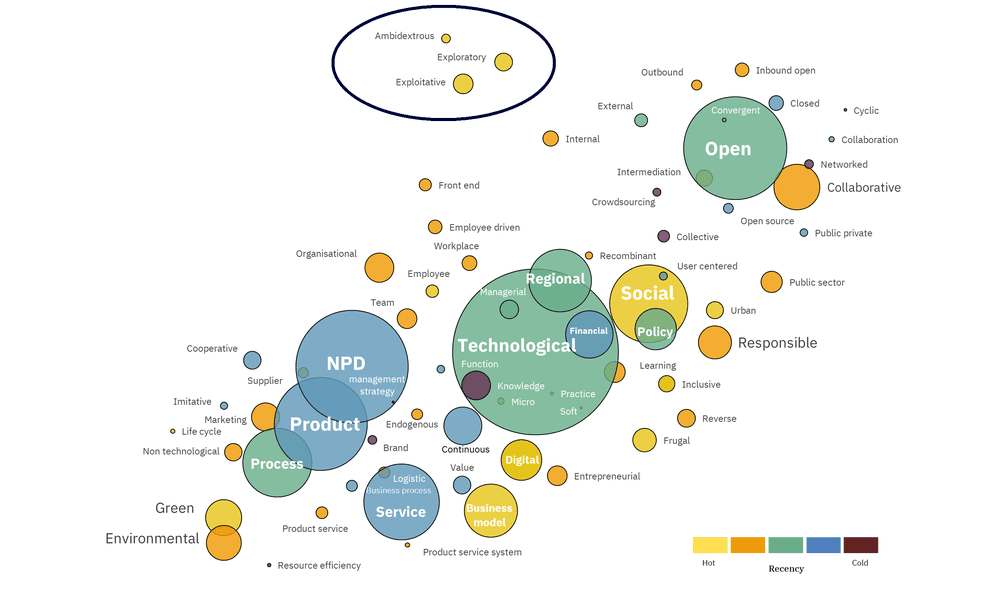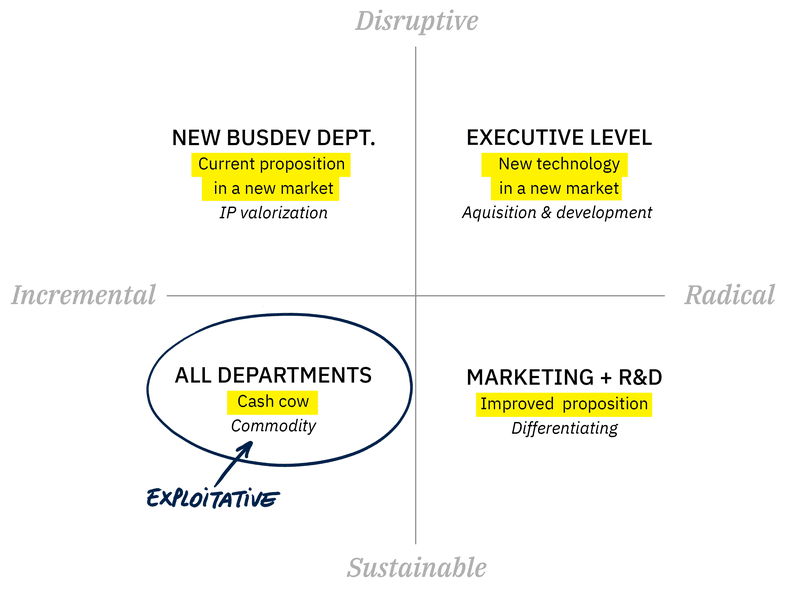Organizational ambidexterity is a recent, emerging topic within the innovation management landscape that deserves a closer look. It also links to two other trending innovation types: exploitative and explorative innovation.
Innovation management is a young discipline of 20 years. We notice an exponential growth in academic research papers since the early 2000’s. Creax analyzed over 54.000 scientific papers and came to some interesting conclusions, we want to share. Innovation is crucial and of strategic importance to safeguard the future of the company. At the same time, the research illustrates why companies still struggle with efficient innovation. It is complex and has become an expertise as such. To unveil the innovation challenge, we publish this series of thought provoking insights. We kindly invite all readers to comment and contribute.
Organizational ambidexterity is one of seventy innovation types Creax discovered in scientific literature. While it is not the most well-known or most deeply researched innovation subject (the size of its bubble is relatively small), judging by its recency, but it is a new and fast emerging one. And rightly so, because organizational ambidexterity is becoming more and more crucial for organizations today, as this article illustrates.
We will also have a closer look at its relationship with two other trending innovation types: exploitative and explorative innovation.

Literally, ambidexterity is the ability to work both left-handed and right-handed, and often at the same time. Translated to the industry, organizational ambidexterity comes down to an ability to balance the daily streamlined operations on the one hand (e.g. the team’s KPIs), and the uncertain, risky, long-term aspect of innovation on the other. Organizations should be able to simultaneously manage today’s business and cope with tomorrow’s changing demand.
Easier said than done. For decades (manufacturing) companies focused on efficiency and quality, neglecting innovation or pushing it aside as a cost item. While this strategy can be reassuring in the short term (steady income, smooth operational processes), it does not prepare the organization for the uncertainties of the mid to long-term future. And that is before we even consider the competition with start-ups and spin-offs that specifically focus on radical innovations that could disrupt the market.
Focusing on the status quo can consume the lion’s share of the organization’s time – time which cannot be spent on innovation – and it can rock the organization to sleep. If we have a cash cow, what is there to fear?
Doesn’t organizational ambidexterity sound like a paradox? On the one hand, the organization needs to valorize core competences and invest in exploitative innovation. This involves refinement of processes, efficiency, implementation, engineering, account management, business development and so on. Nurturing and herding the cash cow(s) and keep giving the public what it wants, in increasingly better versions. This exploitative innovation is almost always solely based on in-house knowledge and expertise (thinking inside the box).

To keep an eye on the long term and remain future proof, however, companies must also invest in explorative innovation. Discovery, scouting, experimentation, exploring new markets and technologies, not yet mastered by the current knowledge, network or expertise in the company. Explorative innovation is not the refinement of existing products and services for existing markets. It is the discovery and creation of a new range of solutions for the current market or the valorization of your portfolio and technologies in new markets.
So how are organizations supposed to match both exploitative and explorative innovation? Doesn’t this require fundamentally different innovation strategies, structures, processes and contexts? How can you sustain and improve the current, day-to-day business and at the same time venture into the unknown, the unpredictable and the unmeasurable? With no concrete forecast of any return on investment? In short: how can you make organizational ambidexterity work?
The innovation matrix shows that exploitative and explorative innovation are not polar opposites that exclude one another. Rather, they are different ends of the same technology and market axis. The figure shows that at a technological level organizations need to invest in incremental innovation to sustain their market(s). Through thoughtful management this can be coupled with radical innovation (exploration of new terrain), which is equally necessary to feed the existing market with disruptive products or invade other markets with existing ones. By integrating radical innovation, organizations can differentiate themselves from the competition, with bigger margins in their own market as a result.
Hard disk producers tended to make bigger disks with more capacity (incremental innovation to ensure sustainability). In doing that, they failed to pay enough attention to the fast-developing technology of solid-state electronics (e.g., in heart rate monitors), until suddenly this technology took over the basic functions of hard disks in personal computers (radical innovation that creates disruption). In no time, hard disk producers saw their market plummet. Lesson learned: there is a risk of an unpleasant surprise when disruptive innovation invades your market, which you did not see coming because of focusing too much attention to maintaining a sustainable organization.

Looking at the innovation matrix, it is easy to see that for any healthy organization the lower left quadrant – incremental implementations to sustain the market – is the most comfortable one: this is the exploitation part, the performance engine of the company, the cash cow, the beating heart. In short: the domain in which the organization feels at home. Since these activities are all located on the same S-curve, the only certainty is that they will become a commodity over time. To put it bluntly: today’s technology leaders can become tomorrow’s technology losers if they are not paying attention to the other quadrants.
Leaving that comfort zone is not an easy task. It requires the development of new capabilities and the attraction and absorption of external knowledge. In addition, it requires considerable spending on technologies and resources for R&D and marketing. And that’s not all: the disruption of new markets (be it with incremental or radical technologies) requires even more complementary competences to be developed or acquired.
In a nutshell, organizational ambidexterity is the ability to control all four quadrants simultaneously across the organization through thoughtful, top-down supported management that pays attention to cross-skill and cross-departmental cooperation. No company will put all their eggs in the basket of developing radical innovation to disrupt a market. This requires too much company-exotic knowledge and therefore has a high degree of uncertainty and a high price tag attached to it. At the same time, no company can afford to play it safe and only invest in sustaining an existing market with incremental innovation. Hence the need for balance.
The comfort of the exploitation zone, based on in-house knowledge and capabilities, is just the top of the innovation iceberg. The other quadrants all rely on the development of company-exotic capabilities and knowledge in one way or another. But they are equally necessary, if your ambition is to have and sustain a future-proof organization. It is a story of both incremental innovation (relying heavily on in-house knowledge and commercialization through knowledge application) and radical innovation (external know-how and novelty through knowledge creation). Consequently, organizational ambidexterity also implies the managerial challenge of integrating external and internal knowledge.
Within the field of exploitative innovation, everything comes down to an ability to further expand the core-competence knowledge base, distribute it in-house and apply it in the existing market. Explorative innovation on the other hand is facilitated by an organizational structure incorporating cross-industry technology brokerage. The ability to integrate external knowledge relies on a combination of internal absorption capacity and an organizational structure/mechanism that enables external knowledge acquisition. In other words, innovation is (also) a knowledge management process. Innovation is not only the invention of something new, but also, and more importantly, the successful exploitation or commercialization in the market of that invention. Viewed in these terms, novelty and commercialization are two key distinguishing features to recognize innovation.
Handling organizational ambidexterity and proficiency in all quadrants of the innovation matrix therefore boils down to implementing a knowledge management structure that effectively deals with the internal and external knowledge streams. Managing industry-specific knowledge has, in a way, become an Olympic minimum for innovative companies. However, embracing external knowledge acquisition and absorption as an essential part of innovation management further requires a significant cultural change. Innovation is not only a question of knowledge creation (ideation, invention of new ideas), but also of the ability to apply that knowledge (implementation and championing, turning the ideas into commercial success).
The ultimate goal of organizational ambidexterity and innovation is a balanced project portfolio. The key lies in striking the correct balance between both incremental and radical innovation and sustainable and disruptive innovation. To achieve this balance, a well-thought-out innovation strategy is an absolute must. This reduces the risk of ad hoc project management and leads to a balanced innovation project portfolio. This should consist of short- and long-term projects, operational and strategic decisions, tech push and market pull, internal and external knowledge, etc. Finally, aligning your innovation strategy with your business strategy will lead to a well-balanced innovation portfolio, safeguarding your company’s future.
We will continue to share findings and discoveries from our innovation management study, based on scientific publications from the last 20 years. Further deep-dives into the different innovation types and trends, will guide you in managing innovation in your organization. More to come!
Be part of our interactive innovation community. You have any feedback on our blogs? Would you like to see a particular innovation topic addressed? Do you have questions about the innovation challenges you face? Do you want to clear up or align your strategic innovation goals with your business strategy? Then feel free to drop us a message.
Building on two decades of experience with over 1,250 projects in a wide range of industries. Creax is a trustworthy innovation partner.
Building on two decades of experience with over 1,250 projects in a wide range of industries, Creax is a proven innovation expert.